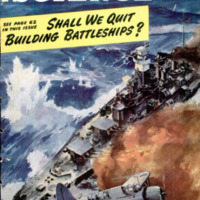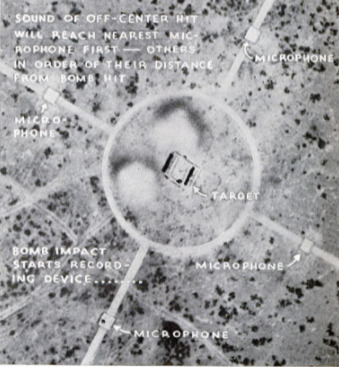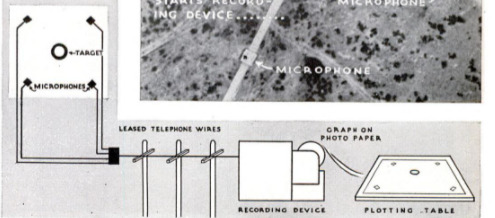Sound Waves help score bomb hits
Item
-
Title (Dublin Core)
-
Sound Waves help score bomb hits
-
Article Title and/or Image Caption (Dublin Core)
-
Sound Waves help score bomb hits
-
extracted text (Extract Text)
-
OFFICERS at the world's largest
bombardier college, the Army Air
Forces Bombardier School at Midland,
Tex., can instantaneously check the ac-
curacy of bombs
dropped by cadets on
targets 20 to 60 miles
away, by means of a
scoring method de-
veloped by Capt. Ed-
ward Peter McKaba.
The new system, as
" explained in the illus-
trations, replaces the
former scoring meth-
od in which aerial
photographs were
made from the bomb-
ing plane. Besides
saving time, photo-
graphic film, and
labor, Captain Mec-
Kabe's system elimi-
nates frequent motor
trips tothe target area.
MACHINE-GUN MOUNTS for Army
trucks provide effective defense
against both air and ground attack.
As shown in the artist's conception
at left, the mount consists of a metal
ring on which a .30 or .50 caliber
machine gun can be turned to fire in
any direction. To fire at enemy air-
craft, the gunner stands on the floor
of the truck. If attacked by ground
forces, he folds the back of the seat
forward to form a platform which
raises his shoulders inside the ring.
Another innovation in truck arma-
ment is a metal rack which replaces
the old leather boot for holding a
rifle or carbine in easy reach of the
driver's hand.
CARBON DIOXIDE fire-fighting systems
are now being installed on oil tank-
ers and on gas-powered auxiliary
vessels used by the Army and Navy.
Carried in liquid form in steel cylin-
ders, the carbon dioxide is kept
under a pressure of 850 pounds per
square inch. When released, it ex-
pands to 450 times its stored volume
and quickly floods the area it has
been designed to protect. The aver-
age flammable liquid requires a 21-
percent concentration of oxygen to
continue burning. When this is re-
duced to 14 or 15 percent by the
presence of carbon dioxide, the fire
goes out quickly. Nozzles are placed
where fire may occur, and are con-
trolled by distant valves.
TRAILERS STEERED FROM THE REAR like hook-and-ladder fire trucks
are solving the problem of transporting large military gliders
from the factory to points of delivery. A signal system insures
teamwork between the driver of the towing vehicle and the
“tiller man” who steers the rear wheels of the trailer. Gliders
are safely hauled over crooked roads, across bridges, and
through cities at speeds up to 40 m.p.h.
mm rs”
-
Language (Dublin Core)
-
eng
-
Date Issued (Dublin Core)
-
1943-04
-
pages (Bibliographic Ontology)
-
105-106
-
Rights (Dublin Core)
-
Public Domain (Google Digitized)
-
Archived by (Dublin Core)
-
Matteo Ridolfi
-
Marco Bortolami (editor)
 Popular Science Monthly, v. 142, n.4, 1943
Popular Science Monthly, v. 142, n.4, 1943




